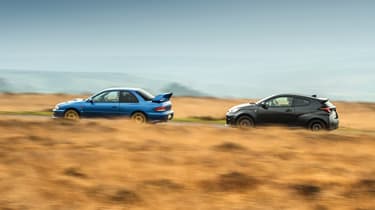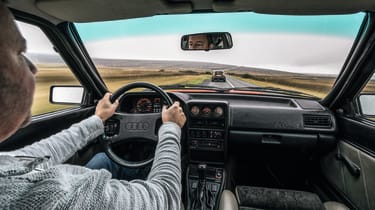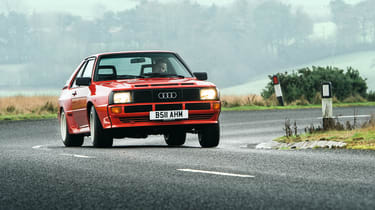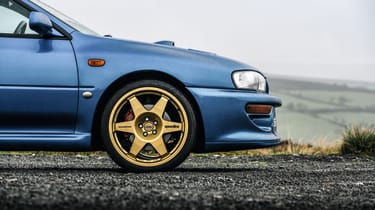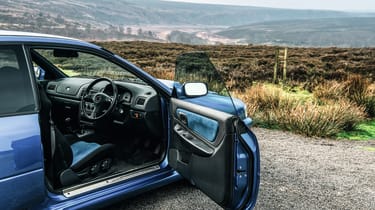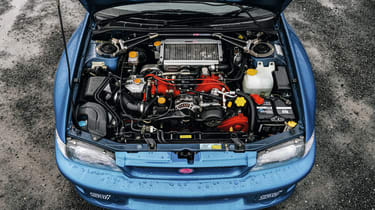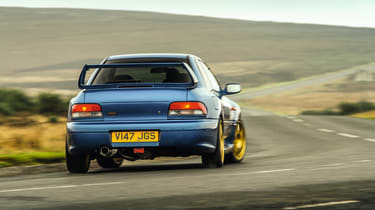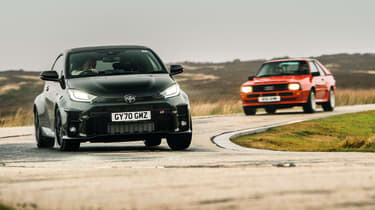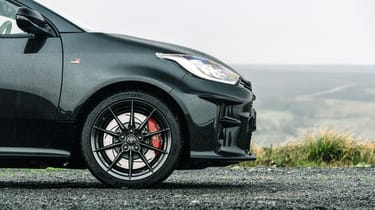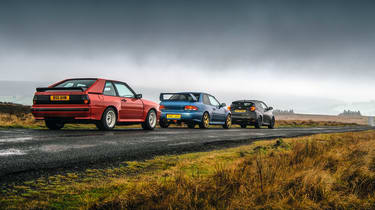Audi Sport Quattro v Subaru Impreza 22B v Toyota GR Yaris
Subaru’s Impreza 22B and Audi’s Sport Quattro are rally-inspired, four-wheel-drive legends. Could Toyota’s GR Yaris match them for charisma and ability? We find out
The eve of a big test is never conducive to a sound night’s sleep. Predictably I’m awake just before my alarm goes off, bleary eyes peering at the bedside clock’s bright digits. The time? 05:55. Three hours north of my cosy bed, one of the UK’s very few Subaru Impreza 22Bs not hidden away in a dehumidified vault awaits my arrival. Even at this ungodly hour the serendipity is clear, ‘555’ being the tobacco sponsor propelled to global prominence during Subaru’s all-conquering efforts in the World Rally Championship. An auspicious portent of an epic few days to come? I reckon so.
Also inbound for our North Yorkshire rendezvous is a lorry containing Audi UK’s 1986 Sport Quattro. And last but by no means least, evo deputy editor Adam Towler is heading to the same spot in a Toyota GR Yaris, thereby completing our trio of celebrated rally specials brought together for this unique comparison test.
> Toyota GR Yaris Gen 2 prototype 2024 review – rally‑bred hatch turned up to 11
So much has been written about the Sport Quattro over the decades it’s almost impossible not to catch yourself thinking in clichés. Thankfully it continues to inspire fresh awe and curiosity. Never more so than when it’s being unloaded from a truck and the keys are handed to you. If you grew up revering Group B rally cars and viewing their road-going counterparts as mythical beasts of the road, it’s a real pinch-yourself moment.
For the best part of 40 years this abruptly abbreviated Audi has stood as the epitome of Group B; a sawn-off shotgun of a car, designed and built with the sole intent of stealing the World Rally Championship. Unlike its purpose-built mid-engined rivals, the short-wheelbase Quattro was far from a clean-sheet design. Audi’s commitment to maintaining a clear connection between this highly evolved rally weapon and regular showroom stock might have been a marketing masterstroke, but whatever they lopped from the wheelbase couldn’t compensate for the front-engined Quattro’s nose-heavy balance.
Conversely, while the short-wheelbase Quattro may have struggled to keep pace with the Peugeots and Lancias on the rally stages, the road cars built and sold to facilitate its homologation were by far the most complete and fully developed of all the Group B contemporaries. This much is obvious from the quality of fit and finish and the luxurious levels of interior trim. Then again, when you consider its price wasn’t so far from that of Ferrari’s 288 GTO when new, you’ll appreciate Audi’s need to build a ‘proper’ road car.
It’s hard not to feel star-struck in the Quattro’s presence. Shocked, too, at just how brutal the reduction in wheelbase is. Audi chopped just over a foot from the middle of the car, more in an attempt to help it rotate into corners than to save weight. Mass was shaved with carbon-Kevlar body panels, although, as we know, the road version was far from stripped-out.
Lift the bonnet and you’ll see that the motor sits forward in the engine bay, pulleys and a cylinder or two sitting on or beyond the front axle centre line. Kevlar shrouds with their exposed yellow and black weave hint at the Sport Quattro’s motorsport pedigree, as do the 2.1-litre in-line five-cylinder’s outputs of 306bhp and 258lb ft – numbers that were on a par with the Porsche’s 911 Turbo of the day.
Once behind the large steering wheel, you’re treated to a view of large and clearly marked analogue dials, heavily grained plastics and chunky switchgear. Switchable ABS and a control for the four-wheel-drive system’s centre differential are curiosities, as is the sight in the rear-view mirror, which reveals a rear windscreen that’s considerably closer than you would expect it to be!
Twist the ignition key and the starter motor chunters momentarily before the engine comes to life with a brief flare of revs and then settles into a resonant idle. The pedals are slightly offset to the centre of the car, but are spaced okay for heel-and-toe work. The brake pedal is firm, the clutch pedal heavy by modern standards. This particular car’s five-speed H-pattern gearbox is a little bit tired if I’m honest, with a lack of spring-bias to the gate and a somewhat discombobulated looseness to the way the lever slots between gears. No matter, as it’s nothing that can’t be minimised with a little patience and mechanical sympathy.
Encouragingly, once you build speed you feel the Quattro begin to get underneath you, suspension settling nicely and steering feel increasing with load. With faster and more meaningful miles you build a picture of a car with two distinct modes. The first is the major league performance car from the same mould as the Porsche 930 Turbo, with long-striding gears, plenty of torque and an uncanny ability to generate speed and carry it across country with little apparent effort. Then you have the lunatic mode. The one that sees a switch from mellow to maniacal. I’d stop short of saying it’s agricultural, but there’s real brutality to the way it delivers its full straight-line and cornering performance. There are two reasons for this: the turbo lag and the four-wheel-drive transmission, both of which require a particular kind of commitment to fully uncork the Sport Quattro.
Below 4000rpm the engine is having a bit of a nap, but from 4500 to 7000rpm it really does rev like the clappers once the boost arrives. You’re certainly glad each gear has plenty of reach as it would otherwise be hard to keep from bouncing off the rev-limiter. The warbling soundtrack is a little less musical than memory serves, with a harder, harsher edge when you work it hard, but it’s still richly characterful and a true echo from rallying’s past.
On the wide open expanse of the North York Moors the short Quattro feels mighty. There’s so much traction and lateral grip it romps across the terrain, sure-footed, impervious to the conditions and brimming with confidence-inspiring poise as it shoulders its way through the curves and bludgeons down the straights.
Attacking a corner crystallises all that’s good and bad about the car. Plentiful grip and monster traction belie the small 15in rims and modest rubber, but the nose-heavy balance, prolific turbo lag and relatively primitive four-wheel drive present a unique set of challenges. Take a conventional approach and you place most of the workload on the front axle, which is fine until the boost arrives, at which point the Quattro pulls itself wide of your chosen line. The knack is to get the weight transferred to the rear with an early, sharp lift of the throttle as you turn in, then get back on the power as quickly as you dare.
With the tail squatting and the turbo lit, the Quattro sits on its haunches and fires out of the corner, rear wheels digging into the road, front wheels pulling just enough to keep things tidy, and with a satisfying smidge of opposite lock. Few cars tackle a corner with more ruthless efficiency or greater effectiveness. If it feels hugely impressive now – and it does! – it must have felt mind-blowing 36 years ago. Now, as then, the legend is well deserved.
Amongst the plethora of Subaru Impreza derivatives one stands supreme. The 22B. Strictly speaking, and rather ironically, it’s not a homologation special. Rather it was built to celebrate Subaru’s 1997 World Rally Championship title, which was won by the beautiful, Peter Stevens-designed Impreza WRC, the first Impreza to embark on rallying’s journey beyond the Group A era in which both Subaru and Mitsubishi forged their formidable reputations.
All credit to Subaru that the 22B was taken just as seriously as any homologation special. In fact it could be argued it went further, such was the bespoke nature of the car. As its name suggests, a special engine – the 2.2-litre EJ22 – complete with unique forged pistons was developed for the car. Due to Japanese market restrictions of the day, power was officially put at 276bhp, but few doubt it was actually developing more than 300bhp.
Short gearing maximised the in-gear performance, while the all-wheel-drive system featured a driver-adjustable centre differential. Indeed, up and down the specification there are uprated motorsport components, including a twin-plate clutch, forged aluminium and rose-jointed suspension, bigger brakes, gorgeous gold BBS alloys, inverted Bilstein dampers (hence the ‘B’ in 22B), special Eibach springs and a seam-welded bodyshell.
STI limited production to just 399 cars for the Japanese market, with a further 25 or so for overseas territories. It may not have been built to homologate the 1997 Impreza WRC, but the 22B’s blend of pedigree and purpose guaranteed it immediate cult status.
Even so, it might come as something of a shock to discover how values have skyrocketed. There was a time not so long ago when £30k would buy you a 22B. These days you’ll need at least five times that to get a decent one, and six or seven times that to get an immaculate car with modest miles. Freakish delivery-miles cars go for considerably more.
Armed with that information, and given how few 22Bs are in the UK, you can perhaps imagine that finding one for this test was something of a challenge. Especially given the time of year and the need to not only photograph the car but drive it as Subaru Technica International intended. I’d begun to abandon all hope when my old mate Richard Tipper of Perfection Detailing came up trumps, putting me in touch with Richard Groves, a client of his who had recently acquired a pristine, 5000-mile 22B. An evo reader since issue 001 (which, incidentally, featured the first UK test of a 22B), Groves committed his car without hesitation, his only proviso being we drive it ‘properly’. What a legend.
Like the Audi, the Impreza has been transported to North Yorkshire. No point in accruing unnecessary ‘dead’ miles on the motorway. Besides, it means we’re treated to another unloading ceremony, which never fails to raise the sense of occasion and anticipation. It looks absolutely perfect, like all your Prodrive/555 blue ‘n’ gold fantasies made real. The wide arches are absolute perfection, the larger diameter WRC rims a forgivable deviation from the standard BBS rims, which are tucked away in Groves’ garage, still shod with their original tyres.
The driver’s door swings light on its hinges, the frameless windows a classic Impreza signature. The simply styled interior is as new, the plastics unmarked, sculpted seats ultra-comfortable, Nardi steering wheel perfect to hold. The soft green backlighting to the instruments takes me back to memories of many happy miles in Imprezas over the years, as does the bonnet scoop poking into view. It’s good to be back.
There’s always been a friendly warmth of character to the Subaru flat-four engine’s soft dugga-dugga-dugga note at tickover. The 22B is typical in this regard, though its EJ22 motor responds particularly keenly to a blip of the throttle, suggesting an unusual freeness and appetite for revs. It’s a feeling that’s amplified by the shorter gearing, which increases the sense of energy and urgency, even when stroking along on modest throttle openings.
It quickly becomes clear that the 22B has a unique character. One rooted in the familiarity and rightness of fast Imprezas, but a step above and beyond the RB5 or P1. It’s more vibrant and explosive, and there’s even a little bit of GT-R-like recalcitrance and lack of refinement in some of what it does. The twin-plate clutch is juddery at low speed, and you can feel the diffs winding themselves up a little bit when shunting around with lock applied at walking pace.
Imprezas were never the last word in front-end feel and this remains the case with the 22B. Cold, wet conditions certainly don’t help, but there’s a slightly glassy sensation to pointing it into fast, sweeping curves that leaves you guessing for that millisecond or two between committing to the corner, easing some lock into the steering and knowing the car is going to stick.
Past experience tells me it’s simply a case of believing. The grip is there, you just don’t get a sense of there being much to lean against until the front end has some lateral loading. Get your head around this and the 22B is a formidable partner, carving its way across the sodden moorland roads with a lightness of touch that’s in stark contrast to the Audi’s heft.
This lightness pervades the whole car. It weighs 1270kg but feels as though it’s 200kg less, such is its ability to change direction and the way it copes with crests and compressions. The clutch is sharp, while the gearshift has a tight gate and a positive but slightly brittle feeling as each gear engages that means you’re measured and precise when guiding the lever. The brakes bite strongly and require only modest pedal pressure. There’s a cohesion to what it does that suggests it was considered and honed rather than uprated without thought to how each component works with the other.
As a result there’s an athleticism in the 22B that’s hard to restrain and impossible to resist. Find some tighter corners and you have the opportunity to be more aggressive with your inputs, braking hard and late, working straight through the glassy phase and finding plenty of front-end purchase. There’s an inherent neutrality to the Impreza that’s the key to its point-to-point speed, its limit marked by a gradual push of understeer rather than anything spiteful. However, where the 22B raises its game is in its ability to be provoked into lift-off oversteer, which can then be balanced and sustained on the throttle.
It takes some effort to get the tail moving, but once it’s in motion the throttle response and perfectly judged steering ratio mean you can slide it smoothly, applying just the right amount of lock and then – perhaps more importantly – straighten things up again equally smoothly. It’s a joy to exploit and a great demonstration of the 22B’s wider and more expressive dynamic repertoire.
And so to the GR Yaris. In the short time since its introduction, this headline-grabbing Toyota has become a sensation. Rightly so, at least so far as people like us are concerned, for it’s the first true homologation special in a generation. Having created such a buzz, the risk of overpromising and underdelivering was high, yet our first proper UK drive in last month’s eCoty confirmed it as a hugely desirable and readily affordable car with abundant talent and a distinctive character.
Shining against its 2020 peers is one thing, but seeing how this little bombshell stacks up against two of the most iconic rally specials of the past is a very different test. Judged purely on car park presence you’d have to say that while it lacks the brutality of the Audi and the knee-knocking looks and McRae magic of the 22B, the GR Yaris does possess something of their aura.
Pumped arches, hungry intakes, squat stance, fat tyres and big brakes. They all add up to a car that expresses its intent without resorting to weird proportions or wild wings, though the rakish roofline and exposed carbon roof are decidedly un-Yaris. Ultimately what’s wonderful about all three of these cars is their sense of purity and purpose. The Yaris is a proper little weapon and no mistake.
Another quality the Yaris shares with its spiritual forebears is an unusual and characterful powertrain, its gutsy turbocharged triple deviating from the norm just as Subaru’s forced induction flat-four and Audi’s in-line five-cylinder turbo did in their day. It’s potent, too, despite its apparent lack of cylinders and cubic capacity, with 257bhp and 265lb ft comparing well against the 22B’s official 276bhp/268lb ft and the Sport Quattro’s 306bhp/258lb ft. It carries very similar weight, too, at 1280kg.
Some people criticise it for not having the exaggerated agility of a Mitsubishi Evo, but personally I don’t mind that so much because there’s a calmness in the steering and handling balance that gives you confidence to commit. Ultimately it’s down to you to put the energy in the car.
If you want it to rotate quickly, you steer it aggressively and use weight transfer to try and bring the tail into play. You can enhance this effect by switching to Sport mode (in this, a Circuit Pack car), which delivers a 30:70 front-to-rear torque split and has a tangible effect on the way you can power the Yaris through a corner. I hear the argument regarding wanting Evo-like yaw, but I’m not sure I would trade the way the Yaris finds grip and traction for overly exaggerated dynamic instability. As it stands, in difficult conditions or on an unfamiliar road you always know the GR Yaris is underneath you.
Character-wise, the engine has a really enjoyable mix of low and mid-range torque with a pleasing appetite for top-end revs – not something triples are noted for. The sound is piped into the car and does lack something in the way of organic musicality. You feel the car’s working harder, but it doesn’t build to a crescendo the way the Sport Quattro and 22B do. However, the gear ratios are great, as is the gearshift, which has a precise, weighty, connected feel. Likewise the steering weight and rate of response is pretty much spot-on, so you know exactly where you are with it within the first mile.
Another real highlight is the brakes, which have terrific power and brilliant pedal feel. You can just squeeze into the pedal and have great confidence in what the car’s doing. The damping is equally sweet: firm but nicely rounded, so it copes with imperfections that would jar in a car that’s too sharply damped or sprung. The Yaris has this compact, four-square feel on the road that exudes confidence and encourages you to drive it quickly, yet it’s also very happy to settle at steady speeds.
What you’re left with is a sense that there’s real maturity to the Yaris. Toyota has thought about it, not just thrown a load of performance parts at the car, cranked a load of support into the chassis and not really worried about its refinement or its ability to cope on a difficult road in tricky conditions. And difficult roads and tricky conditions are what these cars have always been about.
Somewhat unexpectedly, you could argue that of the three the Yaris is the most focused, for it was conceived solely with rally success in mind. The Sport Quattro was an extreme evolution of an already revolutionary rally car, but the Ur-Quattro went rallying as a marketing exercise to prove the advantages of its all-wheel-drive transmission in all weathers and on all surfaces. Group B took this to extremes, but in truth by then not only had Audi’s point long since been proved, but its first mover advantage had actually become an impediment against what were effectively prototype Lancias and Peugeots.
Meanwhile the Impreza Turbo was a high performance series production variant of a rather ordinary family saloon. The genius of Group A’s regulations, plus Prodrive’s expertise, 555’s cash and a roster of great drivers, saw them blossom into world-beating rally cars. Nevertheless these were cars that were made into winners rather than being born to the task.
With three such different cars from such radically different eras it’s hard (some might say foolish) to attempt to bestow some kind of pecking order. What I can say is that the Audi is the greatest event to be in and around, the 22B is the most exciting and, for me at least, the one I connect with on the deepest level. And the GR Yaris? Well, it’s easily the most exploitable, the most connected, the most complete and genuinely characterful, even in this company. That it’s also the quickest across the ground – especially in dicey conditions – feels like it should be a surprise, but is actually inevitable given decades of advancements in tyre, chassis, engine and brake technology.
Perhaps the most remarkable thing about this whole test is that not only have we felt compelled to compare a £35,000 Yaris with an iconic Impreza that now commands £150-200k and an illustrious Audi that’s now pushing £500k, but it goes toe-to-toe with both convincingly. On its own terms and in memorable style. If that’s not something to celebrate, I don’t know what is.
Specs
| Audi Sport Quattro | Subaru Impreza 22B | Toyota GR Yaris | |
| Engine | In-line 5-cyl, 2133cc, turbo | Flat-four, 2212cc, turbo | In-line 3-cyl, 1618cc, turbo |
| Power | 306bhp @ 6700rpm | 276bhp @ 6000rpm | 257bhp @ 6500rpm |
| Torque | 258lb ft @ 3700rpm | 268lb ft @ 3200rpm | 265lb ft @ 3000-4600rpm |
| Weight | 1298kg | 1270kg | 1280kg |
| Power-to-weight | 239bhp/ton | 220bhp/ton | 204bhp/ton |
| 0-60mph | 4.9sec | 5.3sec | 5.5sec |
| Top speed | 155mph | 150mph | 142mph (limited) |
| Price today | £450,000-500,000 | £150,000-200,000 | £29,995 |
Many thanks to Richard Groves for the use of his Impreza 22B. If you’d like to see more of this car, take a look at Richard’s new YouTube channel ‘Challenge The Road’
This story was first featured in evo issue 282.

